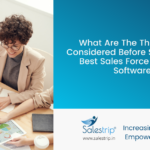Know About Closed Loop Marketing In Pharma Industry In Spades
Published by salestrip on
To really win in the modern age, it’s essential to solve humans first. The sales and marketing team of pharma industry making efforts to sell the product to the HCPs is no exception, where it’s not possible to access and sell something to the HCPs unless they care about what HCPs are expecting. Yes, a lot has changed in the last two decades.
- Since 2000, the profile of HCPs has completely changed- become more and more connected.
- HCPs prefer to access information anytime, anywhere, and anyhow. The digital communication is more favored as opposed to face-to-face interactions.
- There is a great disparity in digital maturity across various countries such as the US and Japan is very advanced in digital communication, but Europe lags.
- The bland presentation of drugs even with iPad no more engages the HCPs.
- Judging the effectiveness of marketing efforts and changes required is difficult.
Moreover, the brand experience lies at the intersection of three questions- why are you loved? What are you good at? Why are you different?
It’s a sign marketers have to set themselves in perpetual motion to innovate every day. The CLM (Closed loop marketing) has a solution to every problem that allows the marketing team to efficiently identify the HCPs expectations, analyze them and then apply to the marketing strategy. CLM is not a new concept in the market. The companies are utilizing CLM strategies since 2005 and it’s enhanced in 2010 with e-detailing tools, post-digital revolution. It was the time when sales reps picked up iPads to record HCPs responses and started reporting it to the marketing time.
Let’s understand closed loop marketing in a nutshell:
CLM is an integrated marketing approach to break through to tech-savvy HCPs in the digital age and refine marketing strategy in such a way that it doesn’t feel like marketing. It banks on the feedback from the targeted group wherein sales reps provide the insights gained from HCPs to the brand managers who leverage the data to measure and revise the marketing content accordingly.
Fundamentally, CLM comprises of four steps:
Initiate: When sales reps get connected with HCPs through a web portal, video conference, or tablet presentation to start a conversation about the intended product.
Uncover: The sales reps using CLM tools record HCPs feedback including their behavior, attitude, and response through automated data collection.
Analyze: The recorded data is used by the marketing team to analyze which message hit the spot and miss the mark. Also, the preferred communication channel for the HCP is found.
Create: Finally, it’s time to reflect the changes in the message using the insights unleashed during the conversation and analyzation phase to keep the HCP interested in the product.
When CLM is incorporated across the multiple digital channels, the product info remains accessible to the HCPs the way they want and when they want. Also, marketers get info about what message is consumed and how and where it’s consumed. The research had proven that a better understanding of the HCPs preferences helps in making communication relevant, effective, and appealing. That’s where CLM is benefitting the pharma industry in several ways.
Take a look at why closed loop marketing is a perfect fit for the pharma industry:
Personalize the targeting
Just the way the retail industry has witnessed immense success with hyper-personalization wherein the better market segmentation based on the customer’s preferences, browsing behavior, previous purchase, and demographics play a vital role. The CLM in pharma industry resonates with the same strategy where the companies tailor the marketing strategy for the specific segment or individual HCP. The market segmentation based on HCPs preferences and behavior aids in targeting HCPs with precise content (Completely informative and relevant data) that ensure the best experience during communication. The data about HCPs collected from various touchpoints such as web portals, applications, or videoconferencing when combined with traditional sales model like- calls, or face-to-face meetings, it positions the sales reps as a source for information and assistance, that in turn, increases the likelihood of conversion.
Enhance communication with HCPs
When you move to the Amazon grocery store, buying the best and fresh products will be the priority. The similar thing resonates with information (latest and relevant) that HCPs keep looking from the sales reps, but when sales reps keep approaching the HCPs with same outdated data, it no longer engages the HCPs. Moreover, the communication remains one-way as HCPs show no interest in it.
CLM converts one-way communication into two-way communication through the up-to-date information presentation that’s packed with stats and visuals. See how? The HCPs are not ready to meet or hear the sales reps due to the irrelevant and outdated information, but CLM tools transform the whole process where sales reps will be very specific in reaching out the HCPs with personalized content that they are looking for. It leads to deeper interactions, upsurge in call-time, and favorable feedback as HCPs prefer to respond to personalized messages delivered through preferred channels.
Integrate sales and marketing approach
The combined efforts of the sales and marketing team is a must-have to increase the company’s sales and profits because sales reps reveal the hidden insights about HCPs that marketing managers sitting on the desk can’t discover.
With CLM, the marketing team already gets meaningful data from sales reps to align the strategy and efforts in line with the HCPs needs. Different marketing plans and how to pitch different products in various cycles can be defined. When the CLM is integrated with an existing CRM system, every team member gets a bigger picture of the market conditions and HCPs responses. The accessibility to hidden insights such as the points missing in the marketing strategy, untapped opportunities, and the plus points keeps them clear about when the right message to be delivered to the right HCPs at the right time, which helps in hitting the sweet spot.
Activate multichannel marketing
Gone are the days, when sales reps sit and wait in the HCPs reception area to get a chance to talk about the product. Presently, the sales reps have a large number of digital avenues to get connected with HCPs and deliver the message in various forms and formats. When the sales reps interact with HCPs through different channels that vary from face-to-face meeting to digital brochure to apps, it’s referred to as multichannel marketing. The myriad of the channels to engage with HCPs increases the financial gains in terms of high top-line growth and reduced cost.
In the pharma industry, digital multichannel marketing helps the sales reps to deliver the message according to every HCP preferences. For instance, the busy HCPs can browse the app or web portal to gain the desired information at the time and location of their choice. The several HCPs interested in question-and-answer, one-on-one, or video conferencing discussions, they can be reached out through webinars.
In this way, when closed loop marketing and multichannel marketing are used in tandem, the team will gain insights into preferences of HCPs for the desired channels they like to interact with the company and obtain the information. Embracing multi-channel closed loop marketing is an ideal choice.
How to successfully implement closed loop marketing in the pharma industry?
The benefits of CLM are followed by drawbacks and the challenges that it emerges for the pharma companies. The technological gap, difficult implementation, massive data, lack of human expertise, and resistance to change and modernization are the hiccups that won’t allow the companies to gain the advantages of CLM to the fullest.
For the successful deployment of CLM company-wide, the CLM must be deployed with optimized content and the team should be trained for its effective usage; the accurate KPIs must be defined over the time to ensure the data collected should be qualitative instead of quantitative and the managers should have a great knack for data analysis; a change management plan must be set up for the sales reps on the field to end up the sense of threat and higher-level managers should consume and trained on new content to gear up them for warmly-embracing the new ways of working.
Conclusion
CLM is a powerful weapon in the pharma companies’ arsenal to increase brand awareness, uplift sales and intensify the bottom line. But, it works only when it’s succeeded in building a personalized relationship with every HCP through refined marketing strategies. The success relies on how it’s implemented, if everything is done right, the sky is no bar. It’s a sign CLM is a double-edged sword that can make or break your success.
It’s better to team up with a company that helps you optimize the sales and marketing efforts and reach the target audience with maximum efficiency. All the best!








0 Comments